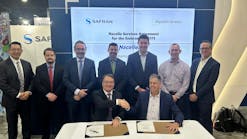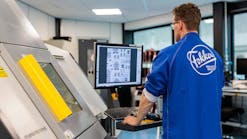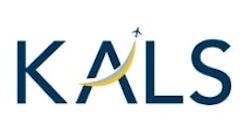Brazilian Scientists from Embraer’s “Silent Aircraft Program” Nominated for Inventor Award
Brazilian scientists Micael Carmo and Fernando Catalano have been selected as finalists by the European Patent Office (EPO) in the Non-EPO Countries category of the European Inventor Award 2024 in recognition of their contribution to sustainable aviation. They were chosen from over 550 candidates for this year’s edition. The award ceremony will be held on July 9 in Malta. The popular prize voting link is available at: European Inventor Award (cstmapp.com).
The two inventors respectively represent the Embraer and the research center teams coordinated by University of São Paulo (USP) that participated in studies to implement engineering methods and solutions to design quieter aircraft. The technology breakthrough contributed to reducing the noise footprint of Embraer’s new generation jet, the E2, by 65%. The E2 also has 25% lower CO2 emissions per passenger than the previous model, and this reduction in emissions can be increased by up to an impressive 85% with 100% Sustainable Aviation Fuel (SAF).
Funded through a collaborative effort between Embraer, the Financing for Studies and Projects (FINEP), and the Research Assistance Foundation of the State of São Paulo (FAPESP), the Brazilian Silent Aircraft program spearheaded by the company, in partnership with research centers from Brazil, England, Germany and the Netherlands, involved more than 200 researchers, granted several patents, and generated important contributions for the development of more efficient jets.
“It is a huge honor for Embraer and the Brazilian scientific community to be represented by Embraer engineer, Micael Carmo, and Professor Catalano, from the São Carlos School of Engineering EESC - USP. We strongly believe that collaboration between companies and research centers can produce innovations to make people’s lives better, and this program is a great example of that,” said Henrique Langenegger, Embraer Chief Engineer. “Congratulations to the entire team, part of what makes the Brazilian aeronautical industry globally respected for its efficiency and sustainability”.
As one of Europe's most prestigious innovation prizes, the award ceremony is organized by the European Patent Office (EPO) to honor individuals and teams with solutions to some of the biggest challenges of our time. The nomination highlights the Brazilian Silent Aircraft Program’s contribution to Embraer’s E2 commercial jets, which are optimally suited for noise-restricted medium-haul flights, offering cost advantages in densely populated airport areas, benefiting airlines, and positively impacting local communities.
The finalists and winners are selected by an independent jury comprising former award finalists. Together, they examine the proposals for their contribution towards technical progress, social and sustainable development, and economic prosperity. All inventors must have been granted a European patent for their invention.
The Inventors
Micael Carmo graduated with a degree in Mechanical Engineering and a Master’s Degree in Acoustics. He has been a key part of Embraer’s interiors, noise, and vibration department for over 20 years and is co-inventor of seven patents related to aerodynamic noise reduction. He has been involved in the “Brazilian Silent Aircraft Program” since the beginning in 2006.
Fernando Catalano has extensive and profound knowledge in aerodynamics, cultivated over years of dedicated research and teaching. Serving as a Professor and former Head of the Aeronautical Engineering Department at the Sao Carlos School of Engineering, University of São Paulo (EESC-USP) since 1982, he now holds the position of dean at EESC-USP. His research has focused on areas such as wind tunnel design, drag mitigation strategies, and the refinement of wing aerodynamics. Additionally, his contributions extend to the realm of experimental aeroacoustics.
Brazilian Silent Aircraft Program
In 2006, Embraer began the Brazilian Silent Aircraft Program to study and evaluate the generation and propagation of airframe noise in jet aircraft. Funded through a collaborative effort between EMBRAER, the Financing for Studies and Projects (FINEP), and the Research Assistance Foundation of the State of São Paulo (FAPESP), the main emphases of the program was on the aerodynamic noise generated by air flowing over and under the wings, the landing gear, and the aircraft's fuselage, as well as the sources of engine noise generated by the jet and by the engine's moving parts.
The research was in collaboration with the Polytechnical School from the University of São Paulo (USP), the School of Engineering of USP in São Carlos (EESC-USP); Federal University of Santa Catarina (UFSC); University of Brasília (UnB); Aeronautics Technological Institute (Instituto Tecnológico de Aeronáutica - ITA) and Federal University of Uberlândia (UFU). Besides that, another four research centers played an important role in the project: University of Twente in The Netherlands; Imperial College and the University of Southampton, both in England; and the German Aerospace Center (DLR) in Germany.
The study was conducted focusing on three distinct approaches that complement aeroacoustics: an experimental part, with flight and wind tunnel tests, a second part where analytical and empirical models are generated, and a third for computational aeroacoustics.
Based on understanding the complex phenomenon of the generation of aerodynamic noise, Embraer adjusted the geometry of aircraft parts, such as wings, flaps, landing gear, among others and performed flight tests in its unit in Gavião Peixoto, São Paulo. Microphones were installed at one end of the runway to register the noise generated by the aircraft during take-off and landing procedures.
As a result, the extensive project was able to accelerate the knowledge of highly qualified specialists in the acoustics field and combine other cutting-edge technologies that support the development of a new generation of quieter aircraft, like the E-Jets E2 commercial jets.





